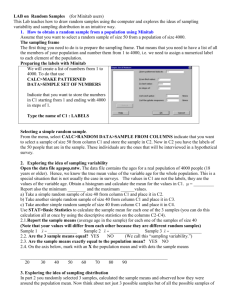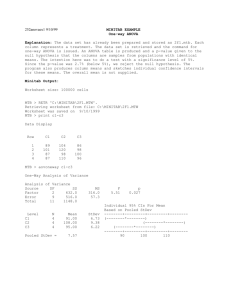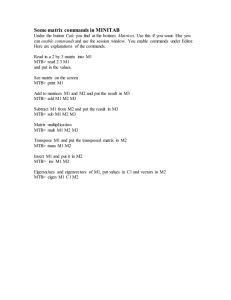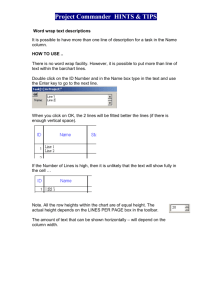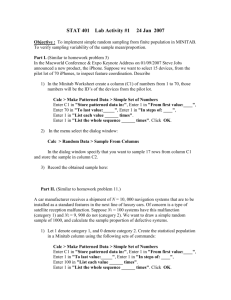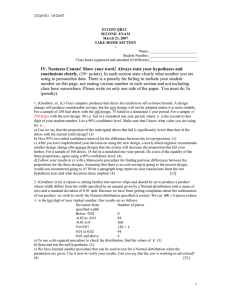Math 1530- Chapter 3 - Lab - Designing experiments
advertisement
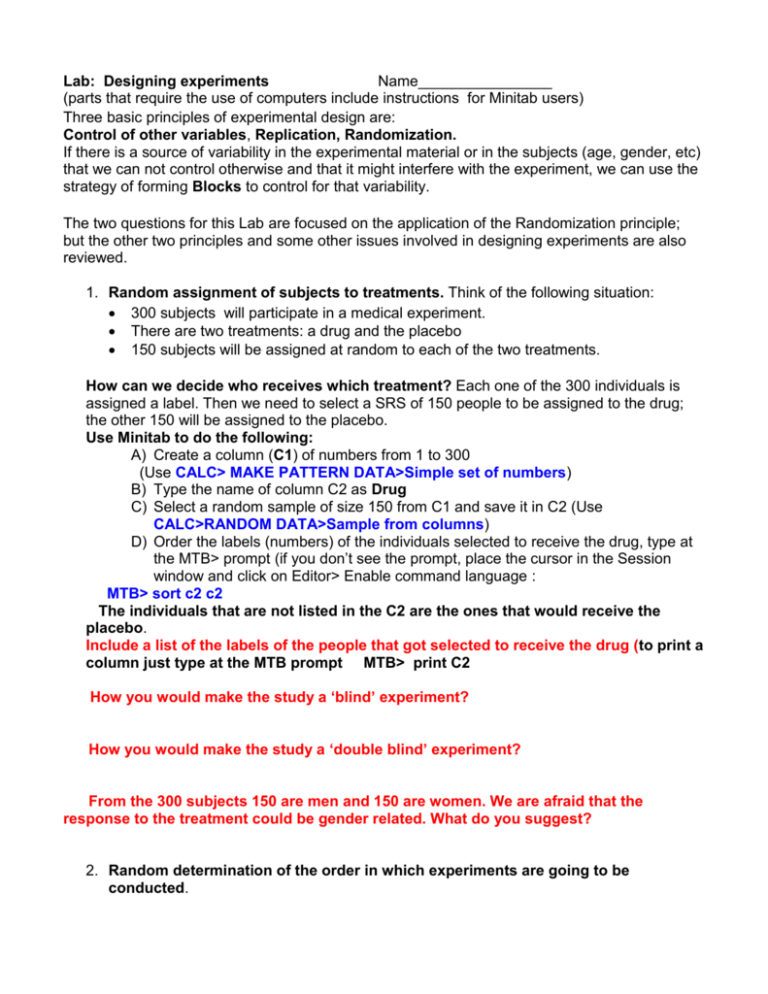
Lab: Designing experiments Name________________ (parts that require the use of computers include instructions for Minitab users) Three basic principles of experimental design are: Control of other variables, Replication, Randomization. If there is a source of variability in the experimental material or in the subjects (age, gender, etc) that we can not control otherwise and that it might interfere with the experiment, we can use the strategy of forming Blocks to control for that variability. The two questions for this Lab are focused on the application of the Randomization principle; but the other two principles and some other issues involved in designing experiments are also reviewed. 1. Random assignment of subjects to treatments. Think of the following situation: 300 subjects will participate in a medical experiment. There are two treatments: a drug and the placebo 150 subjects will be assigned at random to each of the two treatments. How can we decide who receives which treatment? Each one of the 300 individuals is assigned a label. Then we need to select a SRS of 150 people to be assigned to the drug; the other 150 will be assigned to the placebo. Use Minitab to do the following: A) Create a column (C1) of numbers from 1 to 300 (Use CALC> MAKE PATTERN DATA>Simple set of numbers) B) Type the name of column C2 as Drug C) Select a random sample of size 150 from C1 and save it in C2 (Use CALC>RANDOM DATA>Sample from columns) D) Order the labels (numbers) of the individuals selected to receive the drug, type at the MTB> prompt (if you don’t see the prompt, place the cursor in the Session window and click on Editor> Enable command language : MTB> sort c2 c2 The individuals that are not listed in the C2 are the ones that would receive the placebo. Include a list of the labels of the people that got selected to receive the drug (to print a column just type at the MTB prompt MTB> print C2 How you would make the study a ‘blind’ experiment? How you would make the study a ‘double blind’ experiment? From the 300 subjects 150 are men and 150 are women. We are afraid that the response to the treatment could be gender related. What do you suggest? 2. Random determination of the order in which experiments are going to be conducted. Sometimes recycle tires are chopped and mixed with asphalt to build roads. In order to improve the quality of the mix, an aggregate (a chemical product) can be added to the mix. An experiment is being conducted to find a combination of asphalt, chopped tires and aggregate that will produce resistant tires. We will be working with just with the standard type of asphalt but what we really want to experiment with is the type of tire (indicated by the % of natural rubber that it has) and two alternative aggregates A & B. There are three types of tire with 5%, 20% and 35% of natural rubber respectively. The type of asphalt, the time, speed and temperature at which the mixing takes place and the amount of chopped tires, asphalt and aggregate is the same for all the experiments The way we measure the resistance of the combination is to prepare a small batch and freeze it and thaw it successively until it breaks. For each batch we will record the number of freeze/thaw cycles before it breaks (if it does not break we will stop at 50 cycles for each batch). The researcher plans to prepare two batches of each combination. a) Which are the factors? Which are the levels of each factor b) Which is the response variable? What type of variable is this quantitative or categorical? c) How many treatments are there? d) How many experimental units (batches) are required? _________ e) How is the principle ‘Control of other variables' being applied? f) How is the 'principle of Replication' being applied? g) Application of the Randomization principle: Since the experiments are to be conducted one by one because there is only one vessel to do the mix, the order in which the experiments are conducted needs to be determined at random. You will determine the order of the experiment using Minitab. Create three columns : C1 % of Rubber , C2 Aggregate and C3 replicate. Type the appropriate values or names in the columns % of Rubber and Aggregate so that you have all the combinations, repeat each combination twice because there are two batches of each mix. Column C3 replicates has to have numbers 1 and 2 to identify the replicate number of each mix. Create now C4 with numbers 1,2,3,……. to identify all the experiments (you can call that column ID) Notice that the worksheet has as many rows as experimental units you declared in part d). Determine at random the order in which the experiments are to be conducted by selecting a random sample of size 12 (without replacement) from column C4 and save it in C5. (Use CALC>RANDOM SAMPLE> SAMPLE FROM COLUMN) The name of C5 will be ‘order’ and would display the order in which each experiment will be conducted. In real life after the experiments are conducted in the order indicated by C5, the number of cycles that each batch resisted will be typed on column 6 to be analyzed. At the MTB prompt type MTB>print c1-c5 Copy and paste here the list that you would obtain. Which is the first experiment that you will perform? Which is the last experiment that you will perform?
